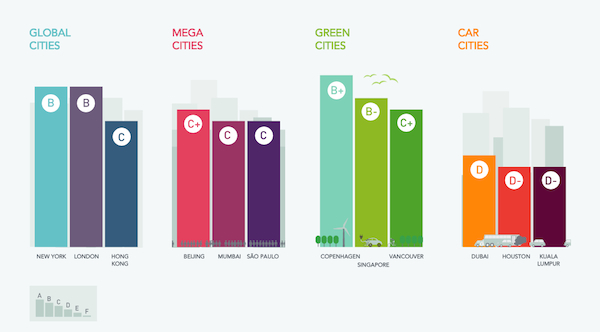A Future Spaces Foundation study looks as transport systems across 12 cities. Marta Catalan Eraso speaks to Make Architects, the designers behind it, about those factors that are key to metropolitan success.

June 2nd, 2016
The above image is by Manganganath, 123rf.com
According to UN-Habitat, an estimated 7 billion people will be living in urban environments by 2050. With this prediction in mind and aiming to provide a guideline for healthier cities, the Future Spaces Foundation, a research initiative by Make Architects, has launched Vital Cities: Transport Systems Scorecard. Copenhagen came out on top as the most ‘vital’ city, with strong sustainability and mobility scores, while Hong Kong scored top marks for accessibility.

Vital Cities: Transport Systems Scorecard – a snapshot
The study is divided into four categories: Global Cities (New York, London and Hong Kong), Mega Cities (Beijing, Mumbai and Sao Paulo), Green Cities (Copenhagen, Singapore and Vancouver) and Car Cities (Dubai, Houston and Kuala Lumpur). Ken Shuttleworth, Founder and Director of Make Architects, and Chairman of the Future Spaces Foundation, explained to IDLHK that the list included cities that resonate with a broad international audience. He also highlighted how Hong Kong, owing to its function as a connector between Mainland China and the rest of the world, has achieved its position in the Global Cities category.

Ken Shuttleworth, Founder and Director of Make Architects, and Chairman of the Future Spaces Foundation
The report offers insightful data that can be applied to our future designs to improve levels of livability as urban density rises – in turn, this will impact on a city’s economic and social success, proposes the Future Spaces Foundation. Shuttleworth pointed out three successful examples that we can learn from in the green, global and megacity categories: from Copenhagen, we can learn to emulate the quality and safety of its cyclist network, where most lanes are dedicated and there are separate traffic lights. Other cities can learn to improve data sharing by following London’s example, as it sets the standard for a successful service that provides open access to real-time transport data. Meanwhile, Beijing stands as the clear forerunner in terms of its efficient public transport network. Its substantive network scores both in terms of connectivity and capacity, serving inner city areas, as well as suburbs up to 30km from central Beijing.
Like Beijing, Hong Kong scores high in terms of its public transport network. The city achieves full marks in all the four categories measuring the quality of the public transport network, which includes capacity, connectivity, frequency and reliability,” says Sean Affleck, Director at Make Architects. “The system already has extremely high coverage, with good feeder services provided by buses and minibuses, and the government plans that by 2021, 70 percent of residential areas will be within 1km of the rail network.”

Sean Affleck, Director of Make Architects
According to Affleck, there is still room for improvement. “While Hong Kong leads New York and London in terms of affordability, there is a stark contrast in the cost of those travelling in the center on the MTR compared to those coming in from the outermost reaches of the MTR network. Spreading the costs more equally between those in the center and outer areas may improve access for more of the population and encourage those with shorter journeys to walk.”
Hong Kong was top of the ranks on accessibility. “All MTR stations have at least one barrier-free entrance, and most MTR buses are wheelchair accessible,” says Affleck. “In addition to this, there are plans to include more measures in future designs, such as lifts, wider ticket barriers or tactile guide paths.
The city’s rankings were lower in the Global Cities category, however: it scored a C overall in this section. “Despite the excellent rating for its public transport network, Hong Kong still scores the lowest overall among the three global cities, brought down by poor scores in the bike and foot network categories, as well as air quality,” explains Affleck. “While temperatures and safety may make it hard to promote cycling more extensively, far more could be done to develop infrastructure and promote greener private vehicle policies as well. This could help the city with another major issue – breathability. Hong Kong had the second highest average reading of nitrous oxide of all 12 cities in the study. As the health and wellbeing of a city’s inhabitants is paramount, measures that help reduce pollution are among the most crucial.”
To see the Future Spaces Foundation’s Vital Cities: Transport Systems Scorecard in full, click here.
The Future Spaces Foundation
futurespacesfoundation.org
Make Architects
makearchitects.com
A searchable and comprehensive guide for specifying leading products and their suppliers
Keep up to date with the latest and greatest from our industry BFF's!

Marylou Cafaro’s first trendjournal sparked a powerful, decades-long movement in joinery designs and finishes which eventually saw Australian design develop its independence and characteristic style. Now, polytec offers all-new insights into the future of Australian design.

Suitable for applications ranging from schools and retail outlets to computer rooms and X-ray suites, Palettone comes in two varieties and a choice of more than fifty colours.

Channelling the enchanting ambience of the Caffè Greco in Rome, Budapest’s historic Gerbeaud, and Grossi Florentino in Melbourne, Ross Didier’s new collection evokes the designer’s affinity for café experience, while delivering refined seating for contemporary hospitality interiors.

In the pursuit of an uplifting synergy between the inner world and the surrounding environment, internationally acclaimed Interior Architect and Designer Lorena Gaxiola transform the vibration of the auspicious number ‘8’ into mesmerising artistry alongside the Feltex design team, brought to you by GH Commercial.
Melbourne is illuminated in June and July for Federation Square’s annual Light in Winter celebration.
As part of significant company growth and a burgeoning range, Interstudio Australia has just opened their second Australian showroom in Melbourne’s design precinct, Flinders Lane.
The internet never sleeps! Here's the stuff you might have missed

Beau Fulwood and Alison Peach on returning to a low-tech, first-principles concept of design as a strategy to combat climate change.

Extrapolating the typology of farmhouse architecture, Cameron Anderson Architects (CAARCH) has drawn on the local architecture of Mudgee in both form and materiality to deliver a surprising suite of buildings.